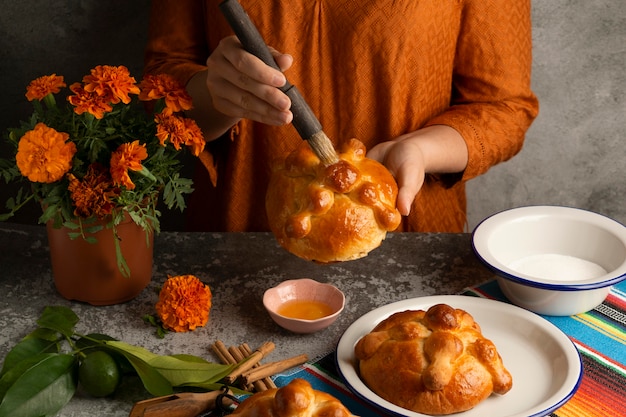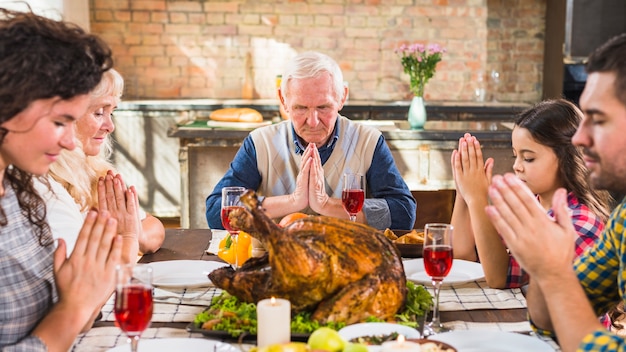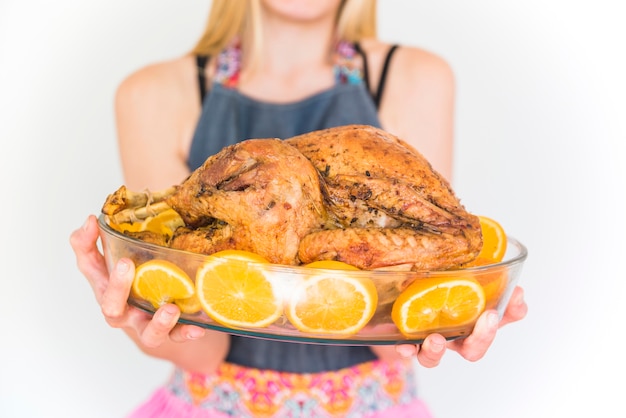Let's be honest, roasting a turkey can feel a bit daunting, especially when you're dealing with a hefty 16-pound bird. But fear not, my friends! I've been tackling turkey roasts for years, and I'm here to guide you through the whole process, step-by-step, with some tips and tricks I've learned along the way. We'll talk about everything from choosing the right turkey to carving it perfectly, so you can be the hero of your next festive feast.
(Part 1) Setting the Stage: Getting Ready to Roast

1. Choosing Your Turkey: It's All About the Bird
The first step in any good turkey roast is selecting the right bird. You want a plump, juicy turkey with a nice even colour. I'm a big fan of fresh turkeys, but frozen ones are perfectly acceptable – just make sure you defrost them completely before you start cooking.
2. Brining: The Secret Weapon for a Moist Turkey
Now, this is where the magic happens. Brining is the key to a truly moist and flavorful turkey. It involves soaking the bird in a saltwater solution, which helps the meat retain moisture and adds a subtle seasoning.
A. The Brine: A Simple Soak
You can find pre-made brines at most supermarkets, which are super easy to use. However, if you're feeling adventurous, you can whip up your own brine. All you need is a large container (a stockpot works great), cold water, salt, sugar, and some herbs and spices like bay leaves, thyme, and black peppercorns. I like to add a splash of lemon juice for a bit of extra tang.
B. How Long to Brine? It Depends
The time you spend brining depends on the size of your turkey. For a 16-pound bird, I recommend brining for at least 12 hours, but 24 hours is ideal for maximum moisture. Just remember, over-brining can make the meat too salty.
3. Getting the Turkey Ready: A Few Final Touches
Once your turkey is brined (or not, if you’re skipping that step), it's time to get it ready for roasting. Pat it dry thoroughly with paper towels. Then, rub it with a generous amount of butter or olive oil. This will help the skin to brown beautifully and create a lovely crispy texture.
4. Stuffing: To Stuff or Not to Stuff?
This is a personal preference, but a classic debate. Some people swear by stuffing their turkey, while others prefer to cook the stuffing separately. If you're stuffing your turkey, make sure you do it right before putting it in the oven. And remember, never stuff a turkey if you're not going to cook it immediately – it's a recipe for foodborne illness.
(Part 2) The Main Event: Roasting Your Turkey to Perfection

5. Preheating the Oven: Setting the Stage
Preheat your oven to 325°F (160°C). It's essential to have the oven nice and hot before putting the turkey in. This will help it to cook evenly and develop that delicious golden-brown crust.
6. The Roasting Rack: The Key to Even Cooking
Place your turkey on a roasting rack set inside a roasting pan. This allows air to circulate freely around the bird, resulting in more even cooking. You can also use a turkey roasting bag, which helps to keep the meat moist.
7. cooking time: A General Guideline
Here's the general rule of thumb for roasting a 16-pound turkey: allow about 15 minutes per pound. That translates to around 4 hours of roasting time. But remember, this is just a starting point. You'll need to keep a close eye on your turkey and adjust the cooking time based on its internal temperature.
8. Internal Temperature: Your Guide to Doneness
A meat thermometer is your best friend when roasting a turkey. Use it to check the turkey's internal temperature in the thickest part of the thigh. You want it to reach an internal temperature of 165°F (74°C) for safe and delicious results. If you're stuffing your turkey, the stuffing should also reach 165°F (74°C).
9. Basting: Keeping It Moist
Basting your turkey regularly helps to keep it juicy and tender. You can use the pan drippings, butter, or a combination of both. I like to baste every 30 minutes or so during the first 2 hours of roasting.
10. Resting: Let It Relax Before Carving
Once your turkey is cooked through, let it rest for at least 20 minutes before carving. This allows the juices to redistribute throughout the meat, making it even more tender and flavorful.
(Part 3) The Grand Finale: Carving and Serving

11. Carving Your Turkey: A Simple Guide
After resting, it's time to carve your turkey. Don't worry, it's not as intimidating as it seems. Start by removing the legs and thighs. Then, use a sharp knife to slice the breast meat into thin slices.
12. Serving Your Roasted Turkey: A Feast for the Senses
Now, the moment you've been waiting for! Serve your beautifully roasted turkey with all your favorite trimmings, such as gravy, stuffing, cranberry sauce, mashed potatoes, and green bean casserole.
(Part 4) Troubleshooting: Addressing Those Roasting Challenges
13. The Turkey is Dry: A Common Issue
If your turkey ends up dry, it's likely that it was overcooked. Next time, try reducing the oven temperature or roasting for a shorter time. You can also try basting more frequently.
14. The Turkey is Raw: An Unexpected Surprise
If your turkey is raw, it's likely that it wasn't cooked long enough. Return it to the oven and continue cooking until it reaches the desired internal temperature.
15. The Skin Isn't Crispy: A Minor Mishap
If the skin isn't crispy, try increasing the oven temperature during the last 30 minutes of cooking. You can also use a broiler to crisp up the skin.
(Part 5) Tips and Tricks for Turkey Roasting Success
16. The Importance of a Thermometer: A Must-Have Tool
A meat thermometer is your best friend when roasting a turkey. It removes the guesswork from determining when the turkey is done.
17. Don't Be Afraid to Experiment: Embrace Your Creativity
There are endless possibilities when it comes to roasting a turkey. Feel free to add your own personal touch, whether it's using different herbs and spices or trying a different stuffing recipe.
18. Don't Overcrowd the Oven: Give It Space to Breathe
Make sure there's enough space in your oven for air to circulate freely. If you're roasting a large turkey, you might need to use two ovens.
19. Pan Drippings: A Treasure Trove of Flavor
The pan drippings are packed with flavor, so don't throw them away! Use them to make gravy, sauce, or drizzle them over the cooked turkey for extra deliciousness.
20. Leftover Turkey: A culinary adventure
Leftover turkey is a culinary treasure! Use it to make sandwiches, salads, soups, or casseroles.
(Part 6) Exploring Different Turkey Roasting Styles
21. spatchcocked turkey: A Faster and More Flavorful Method
spatchcocking a turkey involves removing the backbone and flattening the bird. This allows it to cook more quickly and evenly, and the skin gets beautifully crispy.
22. smoked turkey: A Smoky Delight
For a smoky, rich flavor, try smoking your turkey instead of roasting it. This method requires a smoker and some patience, but it's well worth the effort.
(Part 7) The History of Turkey Roasting: A culinary journey
23. From Wild to Domesticated: A Journey Through Time
Turkeys were originally native to North America. They were domesticated by the Aztecs, and the Spanish brought them to Europe in the 16th century.
24. A Festive Tradition: A culinary legacy
Turkey roasting became a popular holiday tradition in Europe and North America in the 19th century.
(Part 8) FAQs: Your Turkey Roasting Questions Answered
1. How do I know if my turkey is cooked through?
The best way to tell if your turkey is cooked through is to use a meat thermometer. The internal temperature of the thickest part of the thigh should reach 165°F (74°C).
2. Can I roast a turkey in a slow cooker?
You can roast a turkey in a slow cooker, but it will take longer than roasting it in the oven. Make sure the turkey fits in your slow cooker and that it's fully submerged in liquid.
3. How long can I keep cooked turkey in the fridge?
Cooked turkey can be stored in the fridge for up to 3-4 days. Be sure to store it in an airtight container.
4. Can I freeze cooked turkey?
Yes, you can freeze cooked turkey for up to 2-3 months. Make sure to wrap it tightly in freezer paper or plastic wrap.
5. What are some good side dishes to serve with roasted turkey?
There are so many delicious side dishes you can serve with roasted turkey, but some of my favorites include:
- Stuffing
- Cranberry sauce
- Mashed potatoes
- Green bean casserole
- Gravy
Conclusion: Enjoy Your Perfectly Roasted Turkey
Now, you're armed with all the knowledge you need to conquer a 16-pound turkey and create a truly memorable feast. Remember, it's all about preparation, patience, and a little bit of culinary confidence. Don't be afraid to experiment with different techniques and flavors. And most importantly, enjoy the process of creating something delicious! Happy roasting!
Everyone is watching

Corn on the Cob: The Ultimate Guide to Perfectly Cooked Ears
Healthy MealsAh, corn on the cob. Just the name evokes images of sunny days, barbecues, and that sweet, juicy flavour that ...

Perfect Pork Roast Oven Cooking Time: A Guide to Delicious Results
Healthy MealsThere's something truly satisfying about a perfectly roasted pork. The aroma alone is enough to make your mout...

Ham Cooking Time: How Long to Bake, Smoke, or Boil a Delicious Ham
Healthy MealsAh, ham. It's a classic, isn't it? A real crowd-pleaser, especially around holidays. And when done right, it'...

Scallops: The Ultimate Guide to Perfect Cooking
Healthy MealsAh, scallops. Those delicate, sweet, and utterly delicious morsels of the sea. They hold a special place in my...

Spaghetti Squash: The Ultimate Guide to Cooking and Serving
Healthy MealsRemember that time you saw spaghetti squash at the supermarket, looking all bumpy and strange, and thought, "W...
